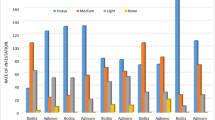Abstract
The offshore area of the South China Sea is an important fishing ground in China. We used a food frequency questionnaire to determine marine fish consumption by local residents, and we detected mercury concentrations in commonly consumed marine fish species. In total, 127.9 g/day of the marine fish consumed was identified in 178 local residents. THg and MeHg concentrations in 209 samples of 22 fish species ranged from 11.3 to 215.0 µg/kg wt and 2.0 to 160.0 µg/kg wt, respectively. The mean MeHg exposure from marine fish to local residents was 0.099 µg/kg bw, accounting for 43.0% of the provisional tolerated weekly intake (PTWI) (1.6 µg/kg bw/week), suggesting a low health risk. However, a potentially high health risk (202.2% of PTWI) was identified in those with 97.5% MeHg exposure.

Similar content being viewed by others
References
Bourdineaud JP, Durrieu G, Sarrazin SL, Da SW, Mourao RH, de Oliveira RB (2015) Mercurial exposure of residents of Santarem and Oriximina cities (Para, Brazil) through fish consumption. Environ Sci Pollut Res Int 22:12150–12161
Braune B, Chetelat J, Amyot M, Brown T, Clayden M, Evans M et al (2015) Mercury in the marine environment of the Canadian Arctic: review of recent findings. Sci Total Environ 509–510:67–90
Castilhos Z, Rodrigues-Filho S, Cesar R, Rodrigues AP, Villas-Boas R, de Jesus I et al (2015) Human exposure and risk assessment associated with mercury contamination in artisanal gold mining areas in the Brazilian Amazon. Environ Sci Pollut Res Int 22:11255–11264
Cheng J, Gao L, Zhao W, Liu X, Sakamoto M, Wang W (2009) Mercury levels in fisherman and their household members in Zhoushan, China: impact of public health. Sci Total Environ 407:2625–2630
Chetelat J, Amyot M, Arp P, Blais JM, Depew D, Emmerton CA et al (2015) Mercury in freshwater ecosystems of the Canadian Arctic: recent advances on its cycling and fate. Sci Total Environ 509–510:41–66
FAO/WHO (2011) Report of the joint FAO/WHO expert consultation on the risks and benefits of fish consumption. Food and Agriculture Organization of the United Nations: Rome; and World Health Organization: Geneva
Gao YX, Zhang HX, Li JG, Zhang L, Yu XW, He JL et al (2015) The benefit risk assessment of consumption of marine species based on Benefit-Risk Analysis For Foods (BRAFO)-tiered approach. Biomed Environ Sci 28:243–252
Gonzalez-Raymat H, Liu G, Liriano C, Li Y, Yin Y, Shi J et al (2017) Elemental mercury: Its unique properties affect its behavior and fate in the environment. Environ Pollut 229:69–86
Hsi HC, Hsu YW, Chang TC, Chien LC (2016) Methylmercury concentration in fish and risk-benefit assessment of fish intake among pregnant versus infertile women in Taiwan. PLoS ONE 11:e0155704
Krishna MV, Chandrasekaran K, Karunasagar D (2010) On-line speciation of inorganic and methyl mercury in waters and fish tissues using polyaniline micro-column and flow injection-chemical vapour generation-inductively coupled plasma mass spectrometry (FI-CVG-ICPMS). Talanta 81:462–472
Liu J, Xu X, Yu S, Cheng H, Hong Y, Feng X (2014a) Mercury pollution in fish from South China Sea: levels, species-specific accumulation, and possible sources. Environ Res 131:160–164
Liu JL, Xu XR, Yu S, Cheng H, Peng JX, Hong YG et al (2014b) Mercury contamination in fish and human hair from Hainan Island, South China Sea: implication for human exposure. Environ Res 135:42–47
Liu J, Yin P, Chen B, Gao F, Song H, Li M (2016) Distribution and contamination assessment of heavy metals in surface sediments of the Luanhe River Estuary, northwest of the Bohai Sea. Mar Pollut Bull 109:633–639
Nakamura K, Fujisaki T, Tamashiro H (1986) Characteristics of Hg-resistant bacteria isolated from Minamata Bay sediment. Environ Res 40:58–67
Nunes E, Cavaco A, Carvalho C (2014) Exposure assessment of pregnant Portuguese women to methylmercury through the ingestion of fish: cross-sectional survey and biomarker validation. J Toxicol Environ Health A 77:133–142
Pan K, Chan H, Tam YK, Wang WX (2014) Low mercury levels in marine fish from estuarine and coastal environments in southern China. Environ Pollut 185:250–257
Pethybridge H, Cossa D, Butler EC (2010) Mercury in 16 demersal sharks from southeast Australia: biotic and abiotic sources of variation and consumer health implications. Mar Environ Res 69:18–26
SAC (2012) Maximum levels of contaminants in foods. Standardization Administration of China. GB 2762-2012
Sadhu AK, Kim JP, Furrell H, Bostock B (2015) Methyl mercury concentrations in edible fish and shellfish from Dunedin, and other regions around the South Island, New Zealand. Mar Pollut Bull 101:386–390
Seixas TG, Moreira I, Kehrig HA (2015) Mercury and selenium in seston, marine plankton and fish (Sardinella brasiliensis) as a tool for understanding a tropical food web. Mar Pollut Bull 101:366–369
Storelli MM, Giacominelli-Stuffler R, Marcotrigiano G (2002) Mercury accumulation and speciation in muscle tissue of different species of sharks from Mediterranean Sea, Italy. Bull Environ Contam Toxicol 68:201–210
Thapa DS, Sharma CM, Kang S, Sillanpaa M (2014) The risk of mercury exposure to the people consuming fish from Lake Phewa, Nepal. Int J Environ Res Public Health 11:6771–6779
Yang HR, Kim NY, Hwang LH, Park JS, Kim JH (2015) Mercury contamination and exposure assessment of fishery products in Korea. Food Addit Contam Part B 8:44–49
Zhen G, Li Y, Tong Y, Yang L, Zhu Y, Zhang W (2016) Temporal variation and regional transfer of heavy metals in the Pearl (Zhujiang) River, China. Environ Sci Pollut Res Int 23:8410–8420
Acknowledgements
We thank Gui-yuan Ji, Qi Jiang, Yan-jun Tang and Zhong-jun Dun from Guangdong Provincial Institute of Public Health, Guangdong Provincial Center for Disease Control and Prevention for excellent support during the field work. We thank Shu-guang Hu, Jing Wang and Zu-jian Su from Guangdong Provincial Center for Disease Control and Prevention for their supports in sample analysis.
Author information
Authors and Affiliations
Corresponding author
Electronic supplementary material
Below is the link to the electronic supplementary material.
Rights and permissions
About this article
Cite this article
Chen, Sw., Chen, Zh., Wang, P. et al. Health Risk Assessment for Local Residents from the South China Sea Based on Mercury Concentrations in Marine Fish. Bull Environ Contam Toxicol 101, 398–402 (2018). https://doi.org/10.1007/s00128-018-2388-3
Received:
Accepted:
Published:
Issue Date:
DOI: https://doi.org/10.1007/s00128-018-2388-3




